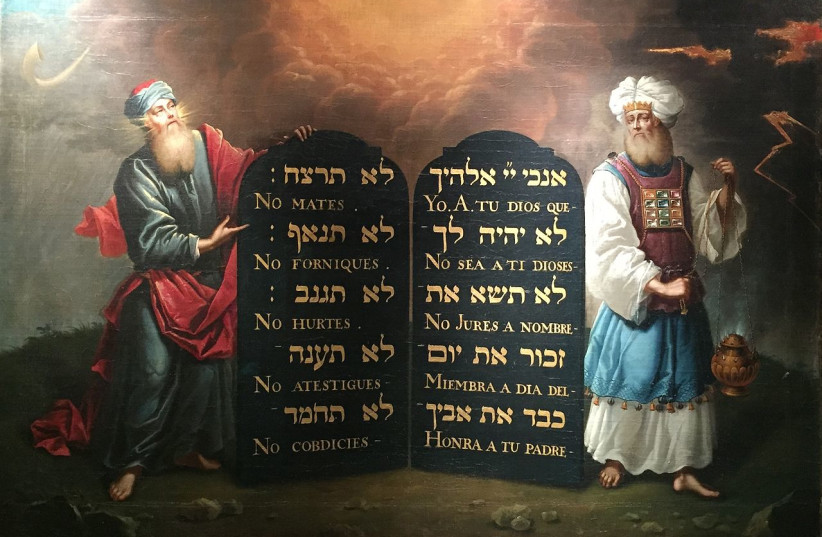The Jewish people do not go out to battle alone. When setting out for the battlefield, we are commanded to take along the Aron Kodesh, the holy ark of the covenant, carrying within it the dual tablet luchot, inscribed with the Ten Commandments given by God at Mount Sinai (Rashi, Numbers 10:33).
The Aron generally resided in the inner sanctum of the Tabernacle; however, at times of war and crisis, it is removed from its sacred abode in order to accompany the Jewish people. When the Aron was stationary, as noted in the Sefer Hachinuch (Mitzva #96), the poles had to stay in place, perhaps so that if war were to break out, the Aron could be immediately carried to join the Jewish army, even at a moment’s notice.
What’s more, perhaps this symbolizes that the Torah is always with us – always carrying us and guiding us, ever on the move with us and governing our behavior, and with us even in our most difficult moments in battle.

There were times that the Israelites did not fully appreciate the function of the Aron in wartime. In the days of the Judges, before the beginning of Jewish monarchy, the Jews fought a war against the Philistines, suffering heavy losses. Fearful for what lay ahead, the elders decided to go to the town of Shiloh, where the Mishkan (“dwelling” or Temple) stood, to bring the Aron to the battlefront, “so that [God] will be present among us and deliver us from the hands of our enemies” (I Samuel 4:3).
Yet despite the palpable excitement among the people at the arrival of the Aron, the Jews once again suffered losses, and the Aron itself was seized by the Philistines (ibid 4:10,11).
In his commentary, Malbim (I Samuel 4:3) questions how the story came to unfold the way it did. Shouldn’t the presence of the Aron have brought merit to the Jewish people?
The answer lies, Malbim argues, in the perspective held by the Jewish people, who believed that as long as they had the Aron along with them, God would certainly save them, even if they were idol worshipers, a belief Malbim describes as “a faith of folly.” For in reality, “the Covenant of the Ark is not an end in itself, but is only so they [the Jewish people] will observe what is written within.”
The Aron does not go out to battle as an elaborate amulet, securing the protection of those around it. On the contrary, the Aron comes to the battlefield as a reminder, to ensure that even in the face of the pressures of war, when fear and anxiety are high and danger is present, we mustn’t lose sight of the great moral and spiritual expectations the Torah demands of us.
Torah challenges us to fulfill Divine Will
There is no time or place, even in war, that the Torah does not challenge us to fulfill the Divine Will. The Aron does not protect us from our enemies; it protects us from our basest instincts when our moral guardrails are challenged.
The Jerusalem Talmud in Shekalim (6:1) presents an argument between the Rabbis and R. Yehuda ben Lakish regarding how many aronot (arks) existed. According to R. Yehuda ben Lakish, there were in fact two aronot, two arks containing the words of the Torah. The official ark, residing in the Holy of Holies, held the second set of intact luchot and a Torah scroll, while the wartime ark contained the shivrei luchot, the shattered first tablets.
If we are to follow R. Yehuda ben Lakish’s position, adopted by Sifri (Numbers 10:33), Midrash Gadol (ad. loc.), Rashi (ad. loc.), and the Netziv in Harchev Davar (ad. loc.), then it strikes me as no mere coincidence that the ark taken out to battle is the one carrying the broken tablets. For wartime is inseparable from brokenness.
We are all experiencing the brokenness wrought by this war: our soldiers in battle; the new widows and orphans; the soldiers who are now physically disabled; families of hostages waiting for their loved ones to return; entire communities that have been dislocated; the innocent civilians; as well as the broader circle of impact on college campuses or communities under threat in the Diaspora.
The fact that the Aron with the shattered tablets was the one sent out to the battle is a recognition of the reality of war. The brokenness of war is reflected within the brokenness of the tablets. During wartime, we all carry the ark with the shattered tablets.
In this moment, our challenge is to face the brokenness created by this war and to refashion ourselves and our society. We are also reminded that this Aron must return back to its home in that Mishkan. As our soldiers make their way home, we need to work to ensure wholeness in our homes, with our spouses and children, and in our places of work and communal spaces.
A great deal has been broken, but as with the shattered luchot, we find wholeness through the opportunity that has come in rebuilding anew. After all, the second, complete set of luchot are a direct result of learning from the experience of the shattered first ones.
Please God we will carry and be carried by the ark with the shattered tablets, as well as the ark with the complete ones.
The author, a rabbi, is the president and rosh yeshiva of Ohr Torah Stone, a Modern Orthodox network of 32 educational and social institutions and programs transforming Jewish life, learning, and leadership worldwide.
